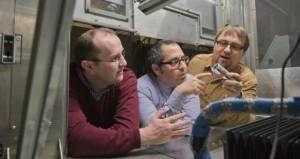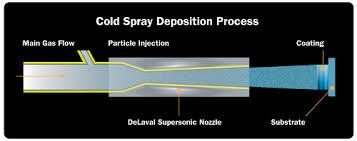 When you think of Ireland, you might think of leprechauns, tall glasses of Guinness beer, and thick wool sweaters. You most certainly think of the color green. But what about a new green 3D printing technology that speeds up helium to twice the speed of sound, injecting metal particles to 3D print at a speed 1,000 times faster than other techniques? What does this have to do with Ireland?
When you think of Ireland, you might think of leprechauns, tall glasses of Guinness beer, and thick wool sweaters. You most certainly think of the color green. But what about a new green 3D printing technology that speeds up helium to twice the speed of sound, injecting metal particles to 3D print at a speed 1,000 times faster than other techniques? What does this have to do with Ireland?
Researchers in the Department of Mechanical and Manufacturing Engineering at Dublin, Ireland’s Trinity College are poised to make great contributions to 3D printing technology. Acknowledging the department’s researching capabilities in the area of 3D printing and additive manufacturing technologies, the European Space Agency (ESA) has just awarded the  department $757,000 for the specific development of the “cold spraying” technique which uses helium to print metal components. This is the largest single ESA research award the university has ever received, and it will be used to develop cold spraying for use in space exploration applications as well as more Earthly applications, such as printing car components and developing the “ultimate non-stick frying pan.”
department $757,000 for the specific development of the “cold spraying” technique which uses helium to print metal components. This is the largest single ESA research award the university has ever received, and it will be used to develop cold spraying for use in space exploration applications as well as more Earthly applications, such as printing car components and developing the “ultimate non-stick frying pan.”
Cold spraying is a more efficient and less expensive manufacturing process that uses metal components engineered “to a very high standard,” which is what distinguishes this technique from conventional 3D printing. Project leader Professor Rocco Lupoi is confident that the technique can be refined without losing efficiency and cost factors. While conventional 3D  printing mainly layers plastic to create an object, cold spraying is capable of creating “finely engineered metal parts while working at room temperature.” This is significant because the heated bonding usually required in printing is not required with the cold spraying technique; no specially gauged temperate environments are necessary, and this complements metals because heat can warp and damage metal components.
printing mainly layers plastic to create an object, cold spraying is capable of creating “finely engineered metal parts while working at room temperature.” This is significant because the heated bonding usually required in printing is not required with the cold spraying technique; no specially gauged temperate environments are necessary, and this complements metals because heat can warp and damage metal components.
“Engineering components usually start with a large piece of metal and this is reduced to the size and shape you need,” says Lupoi. “Cold spray works like a painting machine, applying layer after layer to build up a shape, but done in a matter of seconds.”
There’s another significant advantage to cold spraying: it’s more ecological. It relies on non-toxic helium instead of toxic materials, and this makes it a non-polluting process. In cold spraying, helium gas, accelerated to a high velocity of 2, 472 km per hour (which is twice the speed of sound), can carry injected metallic particles that can then approach the same speed. Also, it uses less raw material overall, which is a very important environmental factor in this technique that MIT’s Technology Review has ranked as a Top 10 breakthrough technology.
Other features that make cold spraying a breakthrough technology is that it doesn’t matter which metals you apply, so unique components can be made more easily, according to the Irish Times. The ability to make any shape and mix materials shows that there are few constraints on this technology, which has been around for about 15 years. So far, the technology has been used mainly for making coatings, due to the high costs associated with the technique. The ESA award will help increase the technique’s speed through refined equipment, while keeping costs down.
The ESA award is also being used to support 3D printing student research. Some of the ESA award money has been used to create a full-time “PhD Studentship in the development of Cold Spray for 3D printing solutions in space applications,” which the department posted on January 7, 2015. From this posting we can also get a sense of some of the project details that will be supervised by Professor Lupoi of the Manufacturing Technology and Systems Research Group. This studentship will provide hands-on experience within an industrial environment developing “state of the art CS systems to achieve set targets in collaboration with ESA.” The project includes designing and building new equipment, like new cold spray nozzles, gas systems, and process simulations. Materials selection/testing, and designing and conducting experiments are also aspects of the overall project.
The ESA award is an excellent opportunity for Ireland to exhibit its tech expertise through developing the cutting edge cold spray technique that can significantly expand additive manufacturing possibilities and reduce pollution and cost at the same time.
What do you think about this line of research? Let us know your response in the Cold Spray 3D Printing forum thread over at 3DPB.com.
Subscribe to Our Email Newsletter
Stay up-to-date on all the latest news from the 3D printing industry and receive information and offers from third party vendors.
Print Services
Upload your 3D Models and get them printed quickly and efficiently.
You May Also Like
Making Space: Stratasys Global Director of Aerospace & Defense Conrad Smith Discusses the Space Supply Chain Council
Of all the many verticals that have been significant additive manufacturing (AM) adopters, few have been more deeply influenced by the incorporation of AM into their workflows than the space...
EOS in India: AM’s Rising Star
EOS is doubling down on India. With a growing base of aerospace startups, new government policies, and a massive engineering workforce, India is quickly becoming one of the most important...
PostProcess CEO on Why the “Dirty Little Secret” of 3D Printing Can’t Be Ignored Anymore
If you’ve ever peeked behind the scenes of a 3D printing lab, you might have caught a glimpse of the post-processing room; maybe it’s messy, maybe hidden behind a mysterious...
Stratasys & Automation Intelligence Open North American Tooling Center in Flint
Stratasys has opened the North American Stratasys Tooling Center (NASTC) in Flint, Michigan, together with automation integrator and software firm Automation Intelligence. Stratasys wants the new center to help reduce...




































